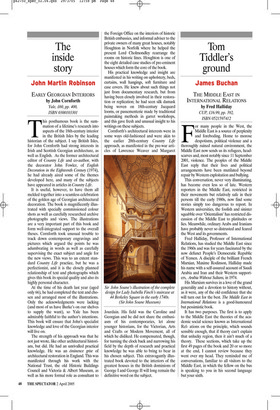The inside story
John Martin Robinson
EARLY GEORGIAN INTERIORS by John Cornforth Yale, £60, pp. 400, ISBN 0300103301 This posthumous book is the summation of a lifetime’s research into aspects of the 18th-century interior in the British Isles by the leading historian of the subject. I say British Isles, for John Cornforth had strong interests in Irish and Scottish Georgian architecture, as well as English. As the former architectural editor of Country Life and co-author, with the decorator John Fowler, of English Decoration in the Eighteenth Century (1974), he had already aired some of the themes developed here, and many of the subjects have appeared in articles in Country Life.
It is useful, however, to have them all melded together into a seamless celebration of the golden age of Georgian architectural decoration. The book is magnificently illustrated with specially commissioned colour shots as well as carefully researched archive photographs and views. The illustrations are a very important part of this book and form well-integrated support to the overall theses. Cornforth took unusual trouble to track down contemporary engravings and pictures which argued the points he was adumbrating in words as well as carefully supervising the exact subject and angle for the new views. This was to an extent standard Country Life practice, but he was a perfectionist, and it is the closely planned relationship of text and photographs which gives this book its special quality and also its highly personal character.
At the time of his death last year (aged only 66), he had completed the text and chosen and arranged most of the illustrations. Only the acknowledgments were lacking (and most of us have Burke’s on our shelves to supply the want), so Yale has been admirably faithful to the author’s intentions. This book will ensure that John’s specialist knowledge and love of the Georgian interior will live on.
The strength of his approach was that he not just wrote, like other architectural historians, but did. He had an unrivalled practical knowledge. He was an éminence grise of architectural restoration in England. This was manifested through his work with the National Trust, the old Historic Buildings Council and Victoria & Albert Museum, as well as his more formal role as consultant to the Foreign Office on the interiors of historic British embassies, and informal adviser to the private owners of many great houses, notably Houghton in Norfolk where he helped the present Lord Cholmondley rearrange the rooms on historic lines. Houghton is one of the eight detailed case studies of pre-eminent houses which form the core of the book.
His practical knowledge and insight are manifested in his writing on upholstery, beds, curtains, wall hangings, soft furniture and case covers. He knew about such things not just from documentary research, but from having been closely involved in their restoration or replication; he had seen silk damask being woven on 18th-century Jacquard looms, or passementerie made by traditional painstaking methods in garret workshops, and this gave fresh and unusual insight to his writings on these subjects.
Cornforth’s architectural interests were in some ways old-fashioned and were akin to the earlier 20th-century Country Life approach, as manifested in the pre-war articles of Lawrence Weaver and Margaret Jourdain. His field was the Caroline and Georgian and he did not share the enthusiasm of his contemporaries, let alone younger historians, for the Victorian, Arts and Crafts or Modern Movement, all of which he disliked. He compensated, though, for turning the clock back and narrowing his field by the depth of research and practical knowledge he was able to bring to bear in his chosen subject. This extravagantly illustrated book devoted to the interiors of the greatest houses in the British dominions of George I and George II will long remain the definitive word on the subject.





























































 Previous page
Previous page